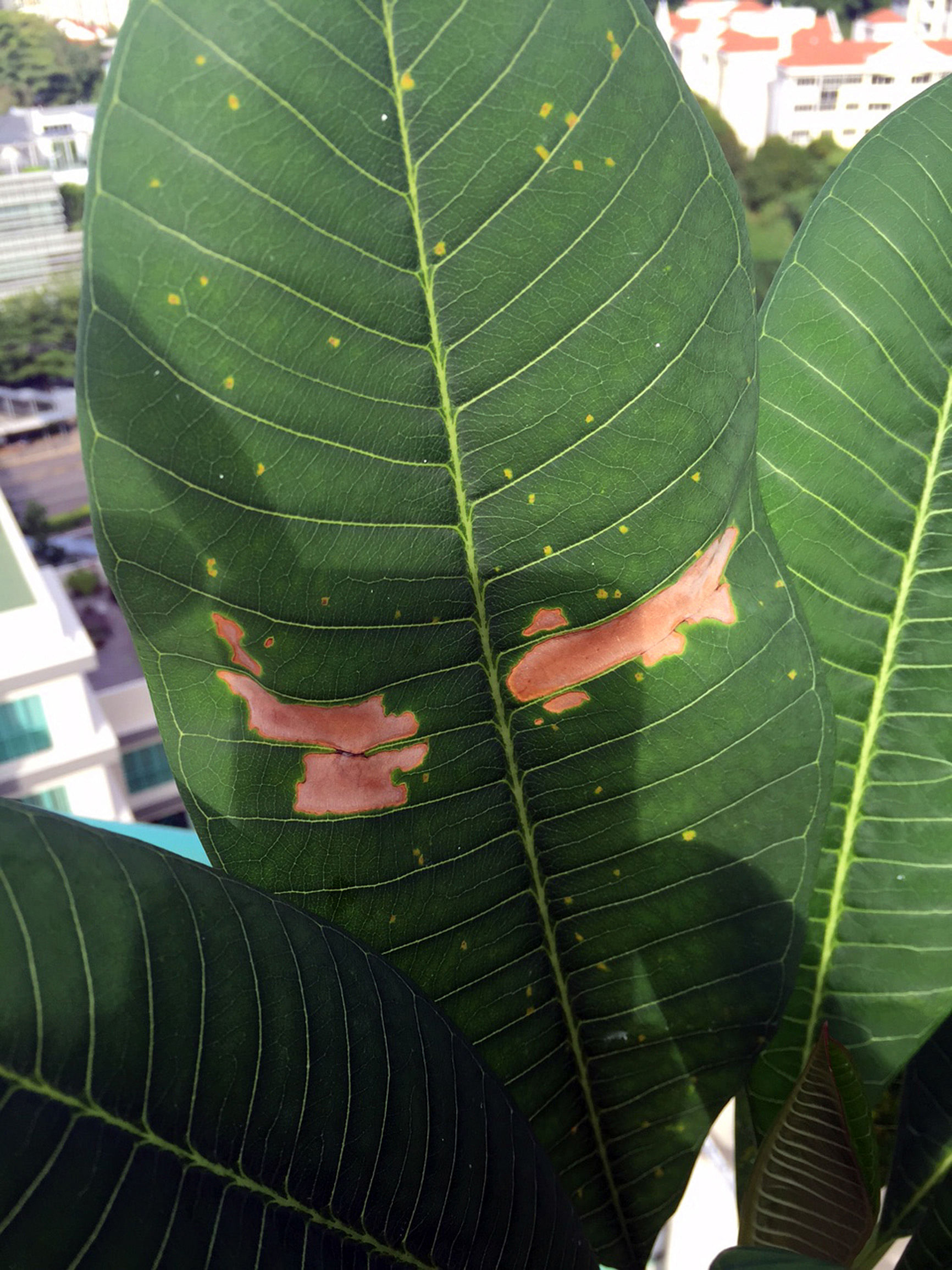Give Dutchman's Pipe creeper a trellis to climb on
I bought this plant from a nursery. It has big, dark red flowers and looks like a creeper. This is the first time I have seen such a plant. What is it and how do I care for it?
Frank Tay
The plant is a species of Aristolochia. It is very likely that it is Aristolochia gigantea, which is commonly sold in local nurseries. Plants in this genus are commonly known as Dutchman's Pipe.

As a climbing vine, it requires a vertical trellis to climb on. It needs direct sunshine to grow well and prefers a moist and well-draining growing media.
Similar to its relatives in the same genus, the plant contains aristolochic acid, which is a toxic chemical compound.
Its leaves are food for caterpillars of two local butterflies - the Common Birdwing and Common Rose.

Lack of sunlight causes yellowing leaves on Japanese Bamboo
I have had this plant for several years. It used to be a leafy plant, on which small birds would come to rest for the night. However, its leaves started to turn yellow and drop recently. Is there a way to revive it?
Thomas Lee
Your Japanese Bamboo Plant (Dracaena surculosa) appears to be suffering from a lack of sunlight.
Although it is often thought to be an indoor plant, it thrives in a location with at least four hours of filtered sunlight.
When plants are placed in an overly shady location, they tend to deteriorate over time with the loss of leaves as well as the lack of robust new growth.
Also, the soil may be too compacted due to the breakdown of organic matter over time. You can incorporate some mature compost into the soil or move the plant into a new pot with fresh potting media.


Chemical fungicide to control rust disease
How can I get rid of these rusty stains on my frangipani plants? I have tried spraying them with white oil. However, the leaves look like they are drying up and there are black bumps (far right) growing on the leaf stems.
Chue Shien
Your frangipani plant is infected by the plumeria rust disease, which is a fungal disease that is prevalent in this plant in the hot and humid tropics. You should remove all infected leaves promptly to reduce the spread of the disease.
Grow the plant in a sunny location with good air circulation.
Do not overwater it to limit the severity of the disease.
An application of the chemical fungicide called myclobutanil can help to control the disease.

Tip: Festive Mini Dragon Fruit plant has stems resembling dragon's body
This small pink fruit is often called Mini Dragon Fruit, but it is not the actual dragonfruit plant.
Instead, it is a close relative of the more commonly grown "keng huay" plant (Epiphyllum oxypetalum). It is botanically known as Epiphyllum phyllanthus var. guatemalense.
The variety that is often sold during the Chinese New Year period, which features twisted stems reminiscent of a dragon's body, is a mutated version of the natural form, often termed as the "montrose" form.
It is an epiphytic plant. It grows best in an open and moist growing media such as coconut husk chunks, with slow-release fertiliser pellets or a water-soluble fertiliser. The plant prefers to grow under semi-shaded conditions. Its night-blooming, cream-coloured flowers are large and fragrant.
Brown, brittle fronds may be result of plant drying out
I have kept Maidenhair Ferns for years, but a few months ago, I noticed that some of the fronds developed brown "stains". These marks grew larger and the fronds turned brown and became brittle. Why does this happen? Also, I noticed that the leaves of some of my other ferns are pale green. What is missing in my fertiliser? Elaine LimThe dry edges of your Maidenhair Fern could be due to a dry air environment.
If you are living in a high-rise apartment, ambient air humidity can be low and there are constant winds at higher levels. These two factors can cause your plant's leaves to dry out.
To resolve this, you may want to cluster other foliage plants around your ferns, as transpiration from surrounding plants can increase the humidity.
However, do not crowd the plants as this can lead to a reduction of light reaching your ferns.
Another factor could be excessive fertiliser salt accumulation in the root zone. You may want to stop feeding your plants for a while - say, for a month or two - and water them regularly so that the salts are flushed out over time.
As for the pale green leaves of your ferns, this could be due to the lack of light.
You may need to raise your plants to a level where they can get sufficient light for healthy growth.
Also, turn your plants periodically to let all sides get sunlight.
• Answers by Dr Wilson Wong, a certified practising horticulturist and founder of Green Culture Singapore (www.greenculturesg.com). He is also an NParks-certified park manager.
• Have a gardening query? E-mail it with clear, high-resolution pictures of at least 1MB, if any, and your full name to stlife@sph.com.sg
